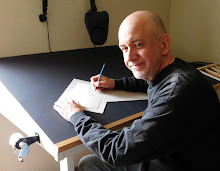
Rain Tern Waterworks, Year Unknown
Charcoal, Graphite; 3 7/8" x 5 1/8"
Here's the finished drawing. The jpeg above is posted at about the drawing's actual size; click on the image to see an enlargement.

Here, it’s been about three weeks since I began this drawing, and a week since the last scan. Sometimes, my drawings develop in a way that seems fairly consistent, linear. With others, though, especially more complex projects that have already come to represent a considerable investment of time and work, I find I may need to take a break, let the piece set for awhile. Tired eyes, tired decisions, that I-just-want-this-thing-done stage sometimes seem inevitable. But over the years, I’ve gotten at least a little better at recognizing those times when I really, really need to not work on this right now.
I took a few days off from this piece, and I’m glad I did. The waterfall at top left needs work, but I like the elements to the right a lot. There’s a ways to go yet, but most of the composition has come into focus. Most importantly, I’m not thinking in terms of simply finishing the drawing. I’m having fun again, and I’m in no hurry.

The near gatehouse, dam and walkway are coming into focus. Here, I’m using harder HB charcoal pencils to define the doorway, other shapes, shadowed recesses, the walkway’s sides.
I’ve begun cleaning up, filling, evening the mist with graphite pencil and kneaded eraser; the walkway’s right edge is nearly defined, and the mist in the lower basin is smoothing out too. For more on this process, see my article Creating A Misty Moonrise in Graphite and Charcoal.

Here I’ve developed the breakaway section further, defined the gatehouses’ shapes and relationship a bit more clearly, and established the waterfall between with a kneaded eraser.
Waterfalls’ brightest highlights are usually found at the top, where the water spills over the surface and edge it’s falling from. I usually establish that edge first, then work my way downward, trying to mimic the flow and direction of the arcs and paths the water follows as it falls.
If I lighten an area too much, or a highlight needs to be moved, I’ll use a Q-Tip loaded with charcoal dust to darken the area again as needed, then reestablish highlights with an eraser. To create or adjust midtones like these, I don’t leave the Q-Tip fully loaded with dust; the result would be too dark- Much or most of the dust gets rubbed off onto scrap before I apply the remainder (carefully) to the drawing.

Here I sketched with another eraser, a Sanford Tuff Stuff stick eraser. For anyone who’s not used one, it looks and works like a spring-loaded ballpoint pen; the eraser stick advances with each click. I sharpen the eraser to a fine point with an emery board.
This is a great tool for drawing in the negative, and for lightening and correcting small stubborn areas where a broader hard eraser would damage surrounding elements.

The ‘Big picture first, details later’ rule has never worked well for me- Probably because it’s never seemed much fun. Though a more exploratory approach has its limitations and downsides too, I’d much rather begin with an interesting passage, and see where that leads.
Here, as usual, I’ve immediately begun developing detail: Deepening shadows with a 6B charcoal pencil, softening them with a Q-Tip; using a sharply pointed kneaded eraser to define shapes. The cleaner the eraser’s point, the brighter the highlights it will lift out, so for prominent highlights like the breakaway section’s edges and corners, I reshape the kneaded eraser often to maintain a relatively clean point. A dirtier point works well for the tones like the breakaway’s top.

Here's a step-by-step look at the progress of my Rain Tern Waterworks drawing. Click on any jpeg for an enlargement.
Whenever possible, I don’t do much sketching before I begin a drawing- I’d rather sketch on the fly, exploring options, fleshing them out, revising, refining as I go.
Initially, I sketch with a kneaded eraser, lifting shapes from a gray background of charcoal dust. Elements established this way are more easily revised than if I’d drawn them with a pencil, and highlights that work well need less cleaning up than if they’d been defined by a pencil line at their brightest edge.
In the scan above, I’ve begun laying in darks with a soft charcoal pencil, blending tones, softening texture with a Q-Tip.

Sometimes I’m ready to commit confidently to a next step even though I have no idea where it may lead. Other times, though, not so much- And I’ve learned to listen a little more closely to that still, small voice that says, Don’t.
Several of my recent drawings are featured in Little Gems: A Collection of Miniature Paintings, at
